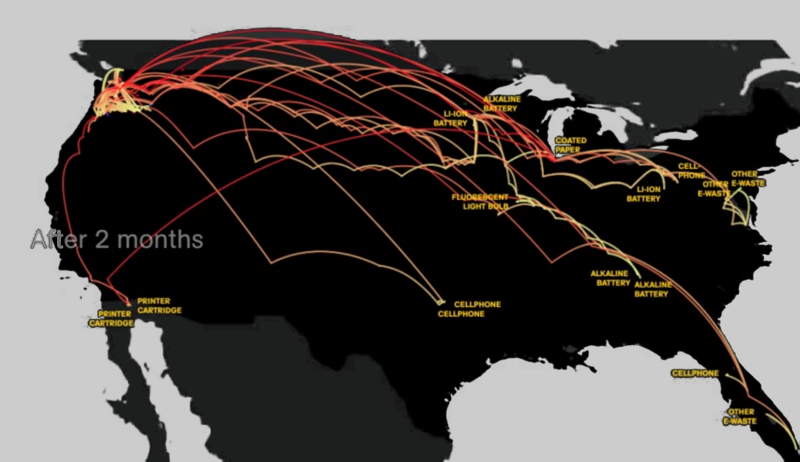
Mapping Waste When Waste is Invisible
by Max Liboiron
Published Q3 2014 in the Grassroots Mapping Forum #6 Order online
Garbage is notoriously difficult to see. Though we deal with municipal solid waste every day, waste infrastructure keeps waste out of sight through bins, black bags, covered trucks, fenced transfer stations, proprietary routes, publicly inaccessible landfills, and laws criminalizing scavenging.1
To overcome this, several mapping projects have sought to visualize the circulation of waste. MIT Sense Lab’s Trash Track (http://senseable.mit.edu/trashtrack/) paired 3,000 GPS locator tags with pieces of trash as they were dropped in Seattle bins. After two months, most waste stayed relatively local, but electronic and hazardous waste moved to other locations in the United States, suggesting that waste moves differently based on what kind of waste it is.
Trash Track map after two months. The only objects that circulate nationally are e-waste.
Geographer Josh Lepawsky visualized sixteen years of e-waste import and export data from 206 territories around the world.2 In 1996, when the data collection began, developing countries dumped waste in less developed nations. Over time the circulation has shifted until developing countries are now exporting waste to developed nations and to each other— a trend less amenable to the verb “dumping,” and contrary to popular discourses about global e-waste circulation.
Both mapping projects produced new knowledge. They are part of a wider trend of evidence-based arguments that defy popular misconceptions about waste. Because waste seems so familiar to us, everyday notions about what constitutes waste, where it is, and how it travels remain largely unfounded and unchallenged. Unfortunately, since many social and environmental problems involve waste, mischaracterizing the phenomenon leads to ineffective solutions. Lepawsky notes that “[e]xport prohibitions as they are articulated under the Basel Convention imagine a world of trade that is increasingly irrelevant with respect to flows of e-waste.”3 In short, if the problem is mis-defined, ill-fitting solutions follow. Thus, one of the purposes of mapping waste is to better pair problems to solutions.
Most waste is invisible because it is never recorded in the first place. The vast majority of waste—about 97% of it—is industrial. This waste is disposed of on industrial private property, without permit or public knowledge, circumventing two major methods of capturing information about waste. Yet even this 97% figure, quoted again and again in academic, popular, and journalistic forums, is based on a single 1987 study by the Environmental Protection Agency.4 This nearly three-decade-old report represents the state of knowledge on manufacturing-waste tonnages and disposal practices in the United States.5 In effect, there is a nearly complete lack of knowledge about almost all waste in the United States.
Detail of Lepawsky’s map of e-waste exporters. Developing countries in red, developed countries in blue.
What does it mean for mapping that a hallmark of modern waste is invisibility? Mappers, researchers, and activists are finding innovative ways to visualize elusive waste; Sense Lab’s pairing of GPS trackers with garbage and Lepawsky’s visualizations of archived data are only two methods. Others include the Public Lab community’s balloon-mounted cameras that can hover over oil spills and transfer station fences; Algalita Marine Research Foundation’s display of ocean plastic samples that are originally meant as “raw” data; Basurama’s public waste audits; the Globe at Night’s crowd-sourced light pollution data; artist Mark Dion’s cabinet of curiosities of things he dug up on the shores of the Thames River; the popular documentation of high water lines after a flood has receded; Litterati’s Instagram hashtag that geo-tags litter. All of these are innovative ways to spatially represent waste that simultaneously expand mapping methodologies given the pervasive and tenacious obfuscation of waste.
Image Credit: Max Liboiron. A sample of ocean plastics obtained from the middle of the North Atlantic Ocean by the Algalita Marine Research Foundation.
Science and technology scholar Sheila Jasanoff writes that, “facts arise out of detached observation whereas meaning emerges from embedded experience.”6 Some representations have a greater likelihood of being experienced by audiences and becoming meaning, even if they can’t be mapped in a traditional fashion. Some techniques simply say: “this is here” in a way that resonates with a viewer. Such “maps” can be visually striking, engaging, theatrical, suggestive or profound, which may be all that is needed for meaning, and, in some cases, coupling a problem to action. Max Liboiron is an Assistant Professor of sociology and technology at the Memorial University of Newfoundland and is the managing editor of the Discard Studies Blog. Liboiron studies “techniques of definition,” the tools and practices used by scientists and activists to make emerging, contested, amorphous forms of harm and crisis legible enough for action. www.maxliboiron.com
- Coverly, E. De, P. Mcdonagh, L. O’Malley, and M. Patterson. “Hidden Mountain: The Social Avoidance of Waste.” Journal of Macromarketing, 2008, 289-303.
- Lepawsky, Josh. “The Changing Geography of Global Trade in Electronic Discards: Time to Rethink the E-waste Problem.” The Geographical Journal, 2014. DOI: 10.1111/geoj.12077
- Lepawsky, t11.
- U.S. Environmental Protection Agency. Draft Final Report: Screening Survey of Industrial Subtitle D Establishments. Rockville, MD: Westat, 1987.
- For a more complete breakdown of this report and its figures, see: MacBride, Samantha. Recycling Reconsidered the Present Failure and Future Promise of Environmental Action in the United States. Cambridge, Mass.: MIT Press, 2012.
- Jasanoff, Sheila. “A New Climate for Society.” Theory, Culture & Society, 2010, 234-235.


